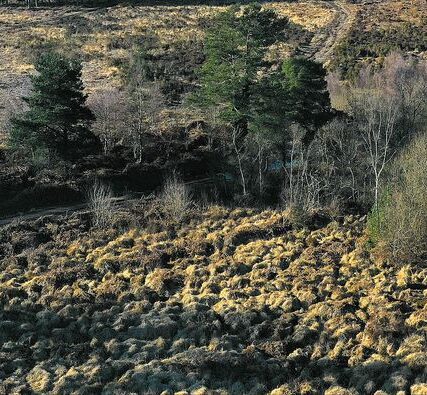
Thanks to the water-loving sphagnum mosses, peat bogs are capable of absorbing and storing large amounts of methane and carbon dioxide. As the sphagnum packs down to form peat (at a rate of 1mm/year if the water levels are right) it locks away up to 3 times as much carbon as woodlands.
Peatlands also act like giant sponges (sphagnum can hold between 30 to 50 times its own weight in water!), intercepting, storing and filtering rainwater, which helps to improve water quality, slow the flow during high rainfall events (especially important for the communities downstream) and it also reduces the fire risk. They really should be called superhero habitats for all the natural services they provide.
In addition to providing those services mentioned, lowland peatlands such as Cleddon Bog are rare. This 15 hectare site has been long recognised as the best example of lowland bog habitat in the Wye Valley AONB and Monmouthshire, and it was designated a SSSI sixty years ago. This rarity makes us all the more proud of it, but all the more concerned for its future.
Cleddon Bog’s ground flora includes Bog Asphodel, bog cottons, sphagnum mosses, heathers, Cranberry, and the carnivorous Round-leaved Sundew, and these are home to a diversity of insects, amphibians, reptiles, small mammals including bats, and birds such as Woodcock, Snipe, Nightjar and the endangered Curlew.
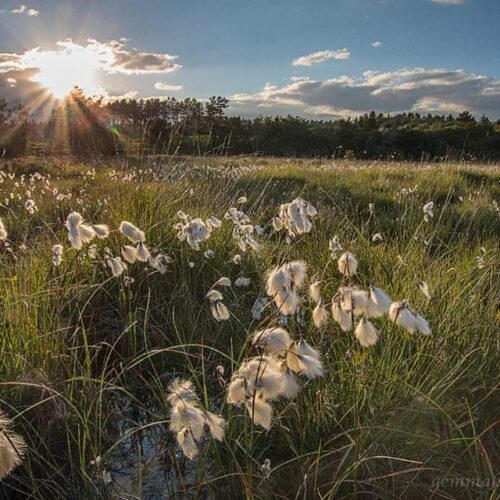
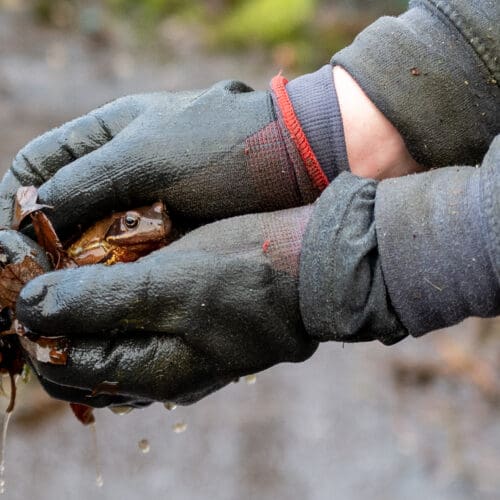
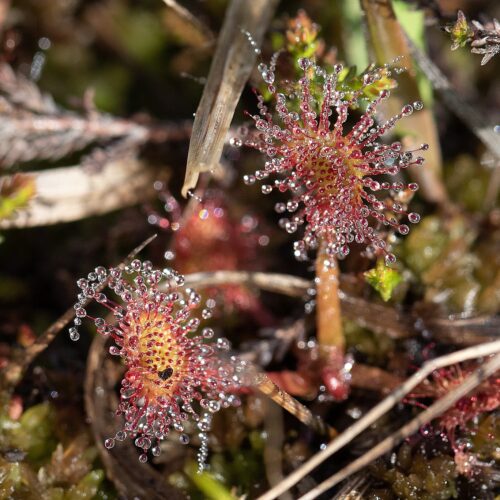
Despite Cleddon Bog being spared the damage and over-exploitation suffered by many of the UK’s peatlands, unfortunately this SSSI is still in decline and it’s in what’s termed an ‘unfavourable status’. This decline is from a more subtle, gradual action – it has been drying out due to changes in drainage, lowering groundwater tables and a change in ecology. The danger is it could be releasing carbon rather than storing it, becoming a driver of climate change.
With grant funding from Natural Resources Wales (NRW) and the Welsh Government’s Sustainable Landscapes Sustainable Places programme, the AONB team has been able to pull together a programme of work for the next couple of years. To reverse the decline of the Bog, we’re working closely with NRW’s SSSI team, Forestry and the National Peatlands Action Programme (NPAP), Gwent Wildlife Trust, the local commoners, local communities and local contractors.
1. Engaging stakeholders and increasing understanding – ensuring the Commoners, the local community and users of the Common are involved and kept up-to-date through social media, site visits and work parties.
2. Sapling control – trees and peatbogs are not a good mix and the density of birch and willow saplings springing up across the bog is a cause for concern. We are working with a local contractor team and have adopted two methods: 1) each winter we mobilise a motivated work-party for a couple of days from surrounding local communities to receive on-the-job training, and then cutting, dragging and stacking the saplings into biomass piles and treating the stumps, and 2) in summer stem-boring the more dispersed saplings growing across the peat (the results from trial 1 are impressive). Do email us if you’d like to join our winter work-party via projects@wyevalleyaonb.org.uk.
3. Conservation grazing – a short conservation grazing trial in March 2023 with 4 Belted Galloways and No-Fence system identified what was required to ensure successful, sustained grazing of this specific site, namely a livestock proof perimeter fence and on-site handling facilities. These were installed in August 2023 and a new ‘Fabulous Four’, pure-breed Herefords, were introduced to the Bog in September 2023 – the first managed grazing of this common since the 1950’s! We have monitored how they moved around the site via the No-Fence heat maps and their welfare was overseen by the volunteer livestock checkers. We’re busy putting plans together for the 2024 grazing. See below for more grazing info.
4. Site Monitoring – We will be monitoring the level of regrowth of the cleared birch, how the cleared areas are re-colonised and the impact of the grazing cattle using fixed point photography, aerial film and photos.
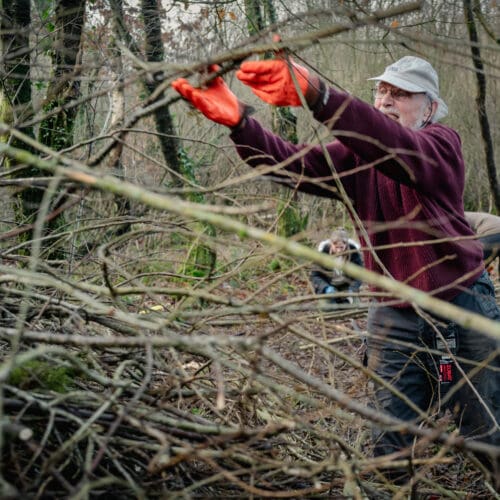
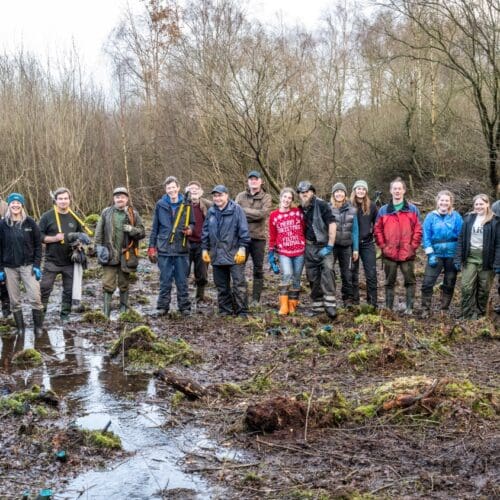
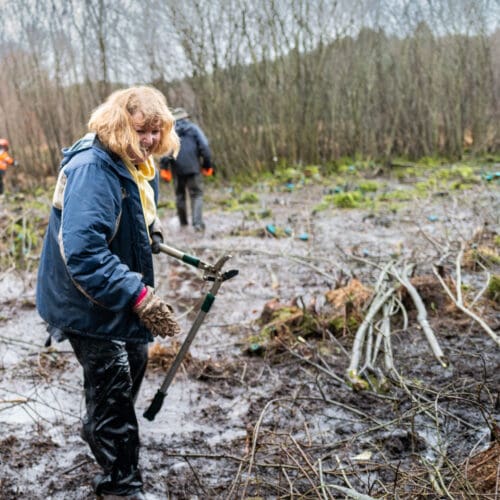
Introducing livestock to Cleddon Bog SSSI and to nearby Beacon Hill recently – both places enjoyed for their public access – is a change and adjustment, particularly for those who have visited the sites regularly for many years. The arrival of the cattle has been greeted by the majority with joy and excitement and we are hearing that people are making special visits to see the fab four. But we’re also keenly aware that, to some, cattle can feel intimidating and uncertainly and anxiety can cause people to alter their walking or riding plans. So, we’ve lined up a series of question and answers which we hope will reduce concerns and arm you with the facts. If you have any further questions please do get in touch via projects@wyevalleyaonb.org.uk.
Why is conservation grazing vital for Cleddon Bog?
As Cleddon Bog’s water levels have fallen, plants that like drier conditions – bracken, purple moor grass (Molinia) and Birch – have become dominant and they are shading out the less vigorous bog plants, leading to a loss of biodiversity and a reduced ability to store water and carbon. However, introduce a few hardy native-breed cattle and they will nibble the fresh Molinia and scrub and trample the dominant vegetation down, giving the sphagnum mosses and other bog plants a better chance of survival.
But the grazing of Cleddon bog is just one part of the equation. The Bog sits within a hydrological catchment that includes the heathland sites of Broad Meend and Beacon Hill, both NRW Forestry estate. Land management practices at these sites has potential to alter the hydrology of the whole catchment including Cleddon Bog downstream. As with the Bog, grazing these heathlands is critical to increasing both biodiversity, and water and carbon capture.
Together with NRW Forestry and one of the active commoners, we are bringing conservation grazing and all its benefits to the landscape scale, with 3 grazing schemes now, connecting and enhancing the heathlands and the peatland.
3D OS and geological map (5X exaggeration) from CCW/NRW (Water Management Consultants).
The Bog’s fence isn’t stockproof so how are the cattle kept where they need to be?
Since the March 2023 grazing pilot we’ve worked with contractors to repair the fence so the Bog is stock-proof once again. Particular attention was paid to securing the fence along the high-speed back road to Trellech.
Also the cattle wear NoFence collars, which look like big cow bells but they’re a fancy bit of technology that allow the grazier to remotely track and monitor their cattle via a mobile phone app, and the creation of a virtual fence called a geofence.
The cattle are trained to wear the collars and they understand the system well. They hear a signal when then get near the geofence boundary and know to turn around when they hear this sound. If they do cross the geofence line, they get an electric pulse (less than they’d receive from an electric fence). The grazing team receive notifications when animals receive tones or pulses, enabling us to monitor any unusual patterns or concerns.
The photo on the right from the autumn 2023 grazing is a heatmap showing the cattle movement around the geofenced area in 1 week. The grazier used the NoFence system to cordon off the deep pool (square shape near eastern edge) because of a safety concern.
Who owns the cattle?
The cattle are owned by Alex and Emily Crawley from Grazing Management Ltd, an award-winning specialist conservation grazing business based in St Briavels. They use traditional breed cattle, sheep and goats that are hardy, to help restore rare habitats. They work with a number of landowners and are increasing conservation grazing as part of regional catchment management strategies.
Who are the Livestock Checkers?
Is there a health and safety risk to the public?
For the March 2023 trial the cattle had access to a section of the Bog’s forestry track (where they were initially released) and, from the feedback we received, the majority of track users were very comfortable with the cattle being there. We watched a number of horse-riders and dog walkers pass by with no reaction from the cattle at all. However, to reduce the cattle to public contact we have installed a new holding pen on the track verge so they are off the track and grazing is focussed wholly on the Bog.
The SSSI is a Common with public access, so a great deal of thought and effort goes into making sure the right cattle are introduced. The current Hereford herd comprises two 2 year old steers, one 2 year old heifer and one 3 year old cow. They have been trained specifically to graze sites with public access and Emily and Aex have spent a long time working with them to ensure they are well used to people, dogs, horses and different combinations of those. BUT, people’s behaviour still has the potential to change their behaviour, so we ask that they are always treated with respect, given space and DO NOT FEED THEM as this can also cause stomach upsets. Also the cattle like to stick together, so please do not walk through the herd, causing them to split up and distress them.
The Grazing Management team offers ‘Meet The Cattle’ sessions for people who are anxious or have concerns they’d like to talk through. A recent session at Beacon Hill saw 12 people and 4 dogs meet the cattle and hear about the project from the team at NRW, and it was a really positive experience for everyone. If you feel you’d benefit from such a session please do get in touch with Paula (number above).
The signs on site at the Bog have a QR code that you can scan with your phone camera that brings up a map showing the grazing area and the animals’ locations. Should you decide to negotiate the very rough terrain of the Bog, this information allows you to decide whether you’d like to encounter the cattle or avoid them and where you need to keep your dogs under close control. If the QR code doesn’t work on site, you can visit this website from home or before your mobile signal disappears: Nofence Grazing Map
What about TB as there are badgers locally?
The cattle are tested for TB every 6 months and are taken off the Bog to their home site for approximately a week each time to be tested.
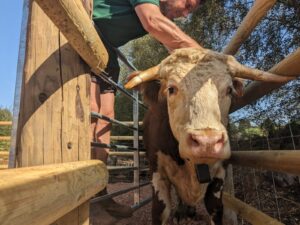
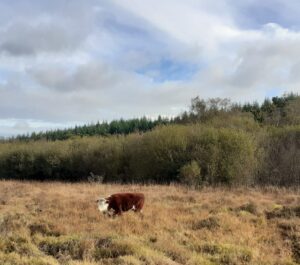
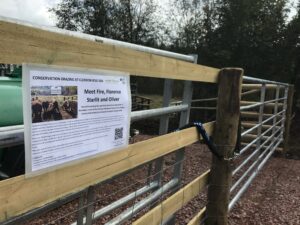
The Common
Cleddon Bog SSSI is a Common with a number of registered Commoners who have various historic rights such as grazing with cows, sheep and geese, removal of fallen wood, fishing and shooting wildfowl and waders (fortunately no commoners exercise the latter!). The AONB Unit has been actively talking with the Commoners about the vegetation management plan and exploring where and when they’d like to be involved. We’re incredibly grateful to one commoner in particular who has been integral to facilitating all the conservation work so far.
Photos courtesy of Gemma Kate Wood, Emma Drabble, Andy Karran, Iain McCallum (drone), Grazing Management Ltd., volunteer livestock checkers and AONB team.